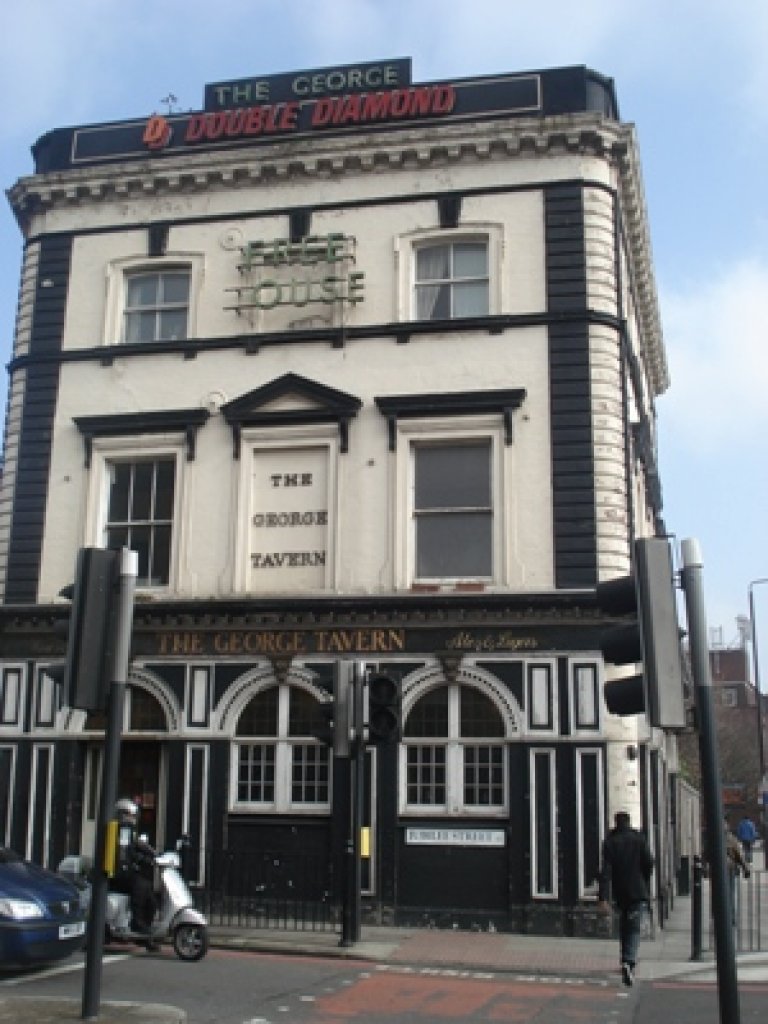George Tavern
373 Commercial RoadStepney
E1 0LA
This pub is not only a grade II listed building, it is also a One Star pub on the Campaign for Real Ale’s (CAMRA) National Inventory with an interior of special national historic interest, and the description is as follows: "A grand corner pub containing some remarkable tiled panels on one wall.
The George Tavern occupies a commanding position at a busy crossroads on Commercial Road. It was built in the 1820s, remodelled in 1862 and then underwent an interior re-fit in 1891 by R. A. Lewcock. It has unfortunately had almost all of its interior features removed but earns a place on the Inventory because it retains on one wall a marvellous series of three large tiled panels containing ravishingly colourful imagery. The left and right panels depict the eponymous monarch flanked by two putti. The large central image shows the pub in an earlier incarnation (when it was called the Halfway House) with a horse-drawn haywain passing by. Its caption – “Ye George Tavern in ye Olden Time. 1654” - demonstrates how the Victorians loved to promote a nostalgic concept of “old England”. The bar servery, which is modern, has been moved to the rear wall on which the tiles are mounted, thus making them easy to miss. But they reward close scrutiny.
The George is a much-loved venue for live music and since 2008 has been the subject of a widely-publicised – and successful - campaign to stop the development of flats adjacent to it, which would have caused the pub’s closure."
The listing description is as follows: “Includes: No. 2A AYLWARD STREET E1. Public house, with accommodation above. Built c1820-25 approximately on site of an earlier pub, the Halfway House. Remodelled 1862, probably by James Harrison. Ground-floor pub interior remodelled 1891 by RA Lewcock. The 3-storey pub on corner site is of primary interest, with 2-storey range continuing along Aylward Street. EXTERIOR: Corner building with 2 principal elevations to Jubilee Street (W) and Commercial Road (S). Brick (now painted) with stucco dressings, modillion cornice under balustraded parapet in front of M-roof. Doors and windows to pub front set in continuous arcade with round-headed arches separated by panelled pilasters, with 3 bays to W elevation and 4 to E, the last bay with a broader, elliptical arch. Arches have decorative floral motifs in bas relief, keystones and cast-iron openwork spandrels. Bracketed cornice above ground floor. Above this, the elevations are identical, each with 3 windows; those to first floor with moulded architraves and bracketed pediments; second-floor windows with architraves and keystones, centre W window blank. String course at 2nd floor sill height. To Aylward Street return, a single bay as at front and then plainer detailing with single door in plain doorcase, rendered ground floor under plat band, and rebuilt brickwork above. East of this, 2a continues as lower two-storey range with blind windows and 1884 and 1843 parish boundary stones that indicated the boundary relative to 'The George'. Attached to east on Commercial Road, the single-storey range: 'Stepney Night Club', is not of special interest.
INTERIOR: Ground-floor pub plan has been opened up, with a modern bar in a traditional style. Cast-iron columns with foliated capitals. E wall has good series of tiled panels, including a painted scene of Halfway House titled 'Ye George Tavern in Ye Olden Times 1654’; Classical scenes with putti, and 'The George', framed with Art Nouveau-style tiles. Cellar has brick-lined passage with shallow barrel-vaulted ceiling and slate shelves in side niches. Features which are likely to be survivals from the 1820s building include a well stair with slender turned newels (balusters replaced), and first-floor doors with panelled linings and fluted architraves with lion masks to corners. Also, uncovered patches of wallpaper in early-C19 neo-classical style to first-floor landing. 3 marble Victorian fireplaces. Panelled window shutters.
HISTORY: The George Tavern and 2a Aylward Street were built approximately on the on the site of the Halfway House, believed to be of mid-C17 origin. Map evidence shows that the Halfway House was rebuilt in the C18, after 1745, approximately 50m to the north east of the earlier inn; neither building appears on Horwood's map of 1819. The present building was probably built c1820-25 and first appears on Greenwood's map of 1827. The pub therefore forms part of the development of Commercial Road, which was created following the Commercial Road Act of 1802 to link the newly-built East and West India Docks to the City boundary. Maps suggest that 2a Aylward Street was built around the same time as the George pub, possibly as a stable or other service accommodation; there was originally a yard to the rear of the pub, but this has been built over. It is unclear whether the vaults, which are mainly beneath the 2-storey range, date from the earlier inn or the 1820s. SOURCES: Pevsner, The Buildings of England, London 5: East, p 527 M Girouard (1984), Victorian Pubs English Heritage (1984), Pubs: Understanding Listing English Heritage (2004), Licensed to Sell”
The indefatigable landlady, Pauline Forster is gradually restoring the remarkable features of the pub, including gilt decoration on the exterior and the revealing of the fantastic ceramic tiling inside. The painted tiled mural (mentioned in the listing description) is signed by ‘A. B. Simpson & Sons, 100 St Martin’s Lane, London’, the same firm who manufactured an equally fine painted tiled mural in the Ten Bells, Spitalfields.
The WhatPub link is here: WhatPub/George Tavern
The Pub Heritage Group link is here: PHG/George Tavern
The George Tavern featured on the Going to the Dogs: Daytime Crawl of the Isle of Dogs, Poplar, Limehouse and Stepney on 17 October 2015.



